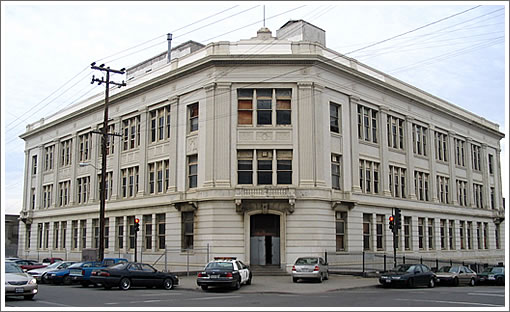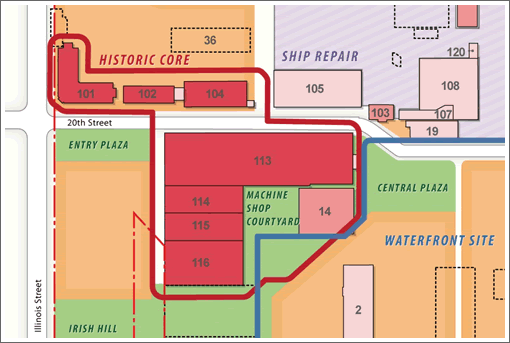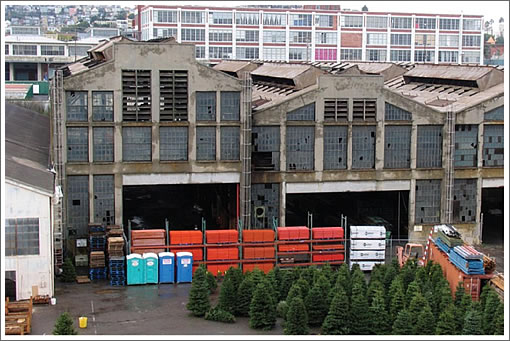
With six suitors lined up to bid on the core redevelopment of San Francisco’s Pier 70, the Port of San Francisco has just opened up the interest list for the rehabilitation of six historic buildings along 20th Street.
These six [buildings] form the portal to a 69-acre historic shipyard site where a recently completed Master Plan calls for 3 million square feet of new development, two new parks along the Bay, retained ship repair operations, and a new national historic district.

Five of six buildings were built during the earliest period of San Francisco’s shipbuilding era – from the late 1880s through the early 20th century. Two were office building supporting the shipyard, the rest are industrial structures.

They are extraordinary, one-of-a-kind structures calling for creative approaches to reuse. The [Request for Interest] is explicitly to locate a variety of novel, interesting, lively, public-oriented uses at the entrance to the historic street to link Pier 70 to the adjacent Dogpatch neighborhood near Potrero Hill.
The historic core includes the Bethlehem Steel Office Building (Building 101), the Union Iron Works Office Building (Building 104), the Union Iron Works Machine Shop (Building 113/114), the Union Iron Works Foundry & Warehouse (Building 115/116) and the Powerhouse (Building 102) which is not to be confused with the Power Exchange.
Letters of intent are due by June 1 after which the Port will invite detailed proposals.
I always wondered how San Francisco could have a housing shortage when we had so many falling apart warehouses on the waterfront on the east side of town.
I am really glad to see something being done with them, but wouldn’t it just make more sense to tear them down and build apartments?
^ All socialist, planned and price-controlled markets experience shortages. SF is no different, so you don’t need to wonder any longer.
I think the implication is that “the market” has decided that margins on residential units, even the “luxury” units so beloved by Schumpeterian creative destruction-loving capitalist real estate “developers” in this city, aren’t large enough to cover the substantial overhead that’ll impose itself on anyone attempting to build on the site.
From the ROI document, subsection entitled “The Offering”:
Tearing down these buildings wouldn’t solve the underlying problem that the city’s trying to get at here, which based on what I’ve read, is that somebody with deep pockets is going to have to do a substantial amount of work on the site before they can remodel anything. Most developers wouldn’t touch this site with a ten foot pole, and the others who would would probably quit as soon as they got the environmental impact report back and leave the site to the EPA to clean up.
To top it off, from what I understand (haven’t been following this initiative that closely) they’ll only get a long-term lease, not own it, so they won’t be able to re-sell it when they’re done. From pg. 03, same document, linked-to above:
Perhaps someone will make a case tomorrow here that there aren’t enough luxury rental units available in and around The City and so the Pier 70 site should have been made available to build some more of them, but as it stands I can understand why they chose to go the commercial route.
NoeValleyJim – Most of the pier 70 site will be razed and developed with new buildings so there will be plenty of brownfield land to start anew. This historic core is worth saving and though the environmental issues are serious, none of the remediation required is especially daunting.
I’m surprised though with the info that Brahma brings up about the lease not to exceed 66 years. I’d think that developers need a stronger motivation to invest in this project. Maybe the city should have gotten the America’s Cup involved here instead ?
It’s a grand high-ceilinged space, that Union Iron Works machine shop. Ever look in there? Definitely to preserve. It should be the centerpiece of any rehab project on the site.
That area does need to be redeemed from use as the main city car impound. It has been sad to see such a big piece of working waterfront history used so long for a function that is pretty much the essence of enforced stagnant decay.
Whole lot to clean up there, btw. Unspeakable weird things get left in impounded cars.
I only hope the remake doesn’t come out too impossibly slick & that it will still be possible to maintain some shred of a maritime economy on the site.
There was a “workforce housing” ballot proposition several years ago to allow higher density housing in the Central Waterfront in exchange for more units set aside for middle class housing.
Opponents called it a giveaway to developers and pro-gentrification, and it was defeated.
The port is now arranging visits this month for interested parties. Contact Lynda Swanson if interested. Her contact details are at the bottom of this web page : http://www.sf-port.org/index.aspx?page=1559